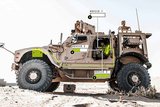QinetiQ builds next-gen GNSS receiver
QinetiQ has built a next-generation global navigation satellite system (GNSS) receiver that will incorporate signals from the Galileo GNSS, the company announced on 16 July.
The navigation receiver will also utilise the Public Regulated Service (PRS). It is a multi-constellation, multi frequency receiver designed to process Galileo PRS service encrypted signals and open services such as GPS. Galileo is the European equivalent of GPS.
The development marks a major step in developing a navigation, tracking and timing product for end-users with mission critical needs, such as emergency services, the military and governments across Europe.
The prototype is an all-in-view receiver that can receive and process the Galileo PRS, Galileo Open Service, GPS Standard Positioning Service and other GNSS signals such as the Chinese Beidou and Russian GLONASS systems. It is also designed to use space-based augmentation services such as EGNOS and WAAS.
The receiver is based on the SEM-E military standard form factor and can be integrated into multi-sensor navigation systems. It provides protection against spoofing and jamming. A suite of products is expected to be ready by 2020, to coincide with the Galileo project's completion.
Nigel Davies, head of secured navigation group, QinetiQ, said: 'We are delighted that, after years of QinetiQ R&D and collaboration with the EU, European Space Agency (ESA) and UK government, we have achieved this major step towards our goal of offering robust navigation products using Galileo. It is a significant breakthrough for us to have built a fully operational receiver on a platform which proves our product architecture, functionality, and algorithms.
'Our next step will be working to refine the product family and preparing it to be brought to market, which includes developing additional features and reducing its size to that of a postage stamp, in a form factor similar to our existing, highly successful, Q20 receiver. We have full confidence in this product and are proud to be at the forefront of this exciting new phase in European navigation.'
More from Digital Battlespace
-
![Intelsat boosts SOF communications with advanced multi-orbit technology (video)]()
Intelsat boosts SOF communications with advanced multi-orbit technology (video)
Intelsat is enhancing communication solutions for special operations forces through an approach focusing on multi-orbit capabilities, network integration, and advanced terminal technology.
-
![Raytheon missile warning data processing system declared operational]()
Raytheon missile warning data processing system declared operational
Raytheon’s Future Operationally Resilient Ground Evolution Mission Data Processing Application Framework (FORGE MDPAF) is designed as a modular and adaptable framework to provide integration of mission focused applications to handle information from satellites.
























